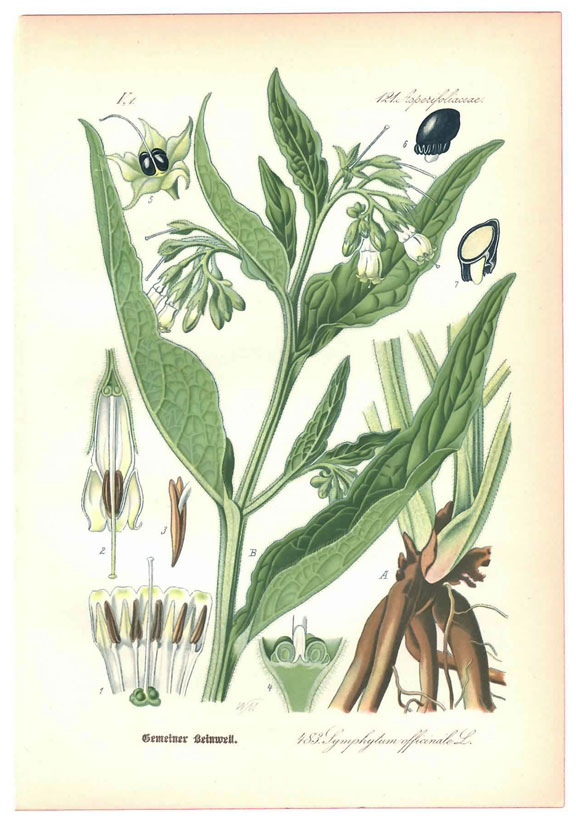Krista's Herbarium
a collection of herbal remedies, recipes, and reveries
Comfrey

Symphytum officinale
Medicinal Notes
According to The Pharmaceutical Journal:
“Dioscorides’s ‘Materia medica’ is the oldest materia medica in Europe. Created at the same time as, but independent from, the ‘Naturalis historia’, it has been shaping European and Arabic phytotherapy for nearly 2,000 years
Dioscorides also mentions comfrey: “The roots below are black on the outside and white and slimy on the inside. …Finely ground and then drunk they are beneficial for those spitting blood and those suffering from internal abscesses. Used as a compress they also seal fresh wounds. They have a joining together effect when cooked with pieces of flesh. They act as cataplasm in the case of inflammation, especially in the anal area.”
Comfrey (Symphytum officinale) derives its name from the Greek term symphyton, (symphytum in Latin), from the root symphyo; “I grow together”.
Harvesting
Foliage is at its best if cut before blooming time. The plant reaches a height of over two feet and spreads to more than a metre across. Comfrey leaves have a high moisture content and dry more slowly than some of the herbs you may be used to working with. Make sure the leaves are crumbly before you store them, though, since any remaining dampness will cause mold.
Harvest roots in the fall. To preserve comfrey for later use, roots can be sliced and dried or macerated as an oil-infusion.
Constituents
Comfrey contains tannin, rosmarinic acid, allantoin, steroidal saponins, mucilage, inulin, pyrrolizidine alkaloids, gum, carotene, glycosides, sugars, beta-sitosterol, triterpenoids, vitamin b-12, protein, zinc.
Uses
According to Annie’s Remedy:
“Comfrey is a marvelous herb and is one of the best-known healing herbs of all times. Comfrey relieves pain and inflammation caused by injuries and degeneration, especially the symptoms of rheumatoid arthritis and osteoarthritis. Comfrey salves and oils can be used in arthritic pain relieving massages. In a recent study patients with painful osteoarthritis of the knee treated with comfrey root extract in an ointment showed a reduction in pain , mobility of the knee improved and quality of life increased. (NIH)
Comfrey salves, ointments and teas are best known for the topical treatment of burns, skin ulcerations, abrasions, lacerations, flea and insect bites, and just about any skin irritation. Comfrey’s astringent tannins form a protective surface over wounds that promotes healing. You may want to try comfrey or allantoin skin creams for diabetic sores. For weeping eczema, make a tea of comfrey and apply the liquid as a compress. Comfrey relieves pain and speeds healing of pus-filled wounds, and accelerates tissue healing in cases of insect bites.
Fresh leaves can be applied to bruises, fractures, sprains, and other injuries. Many healing effects of comfrey are attributable to allantoin, a compound shown to speed cell production both inside and outside the body. Comfrey works so fast that many herbalists will add antibacterial herbs such as goldenseal or thyme to comfrey salves to prevent sealing bacteria inside a fast healing wound.”
I grow two types of comfrey, yellow which is petite and powerful (found in shady forest patches) and the much larger and ubiquitous purple (found in large groupings alongside our meadow paths).
| The creamy yellow-flowered form is stated by Hooker to be Symphytum officinale proper, and the purple flowered he considered a variety and named it S. officinale, var patens. The botanist Sibthorpe makes a definite species of it under the name patens. |
Because my family is constantly tripping, banging toes and twisting ankles – clumsy, I guess- comfrey poultices are used by us and given also as remedies to my clients very often. I am happy to offer fresh leaves and roots from my garden. My Knit-Together Salve is used topically on any internal wound and as an amazing massage salve to support muscle healing.
Salve/ poultice: Use externally as needed.
There is much controversy about taking Comfrey internally, especially root preparations. Comfrey root contains pyrilizidine alkaloids, which can cause liver damage. I would recommend using Comfrey only as an external healer. ONLY use Comfrey on a wound once you’re sure any infection has been taken care of as it heals skin so rapidly as to overtake any infection before it’s been cleanly dealt with.



It still looks like borage, even though I know borage has a somewhat more coarse texture, and (I think) stays lower. I do not know because it I have never seen it grow to maturity. I think I would like to grow both once I get my garden going again. When I find one or the other growing as a weed, I should relocate it to a place where it can stay.
LikeLike
Comfrey relocates well and I have found that it likes moist, somewhat neglected areas. I throw comfrey pretty much anywhere and it seems happy. I don’t have personal experience with borage in my garden. It grows in the forest around me, but I haven’t yet popped it into my garden.
LikeLiked by 1 person
Borage shows up in the rose garden or anywhere I do not want it. I leave it with the intention of moving it later, but then never bother to move it. It grows up with the roses, and the neighbor takes what she wants from it. I would prefer to give it its own space, and exclude it from the roses. It is useful to know it moves well. The rose garden gets warm and dry, and it does not seem to mind. I would water it more (if I really do move it). My neighbor wants comfrey too. I could get seed for that I suppose.
LikeLike
I’ve never grown comfrey from seed. I’d be curious how that would work out. I have had great success with the lesser (yet more potent) yellow comfrey. It is now popping up all over my garden totally randomly.
LikeLike
Pingback: Healing Herbal Salve: the miracle – Krista's Herbarium